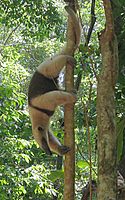Tamandua
| Tamandua[1] | |||
| J.E. Gray, 1825[2] | |||
 Przedstawiciel rodzaju – tamandua północna (T. mexicana) | |||
| Systematyka | |||
| Domena | |||
|---|---|---|---|
| Królestwo | |||
| Typ | |||
| Podtyp | |||
| Gromada | |||
| Podgromada | |||
| Infragromada | |||
| Rząd | |||
| Rodzina | mrówkojadowate | ||
| Rodzaj | tamandua | ||
| Typ nomenklatoryczny | |||
Myrmecophaga tamandua G. Cuvier, 1798 (= Tamandua tetradactyla Linnaeus, 1758) | |||
| Synonimy | |||
Tamandua[8] (Tamandua) – rodzaj ssaka z rodziny mrówkojadowatych (Myrmecophagidae).
Zasięg występowania
Rodzaj obejmuje gatunki występujące od Meksyku do Argentyny[9][10].
Morfologia
Długość ciała (bez ogona) 470–770 mm, długość ogona 400–675 mm, długość ucha 40–54 mm, długość tylnej stopy 80–100 mm; masa ciała 3–8,4 kg[11].
Systematyka
Etymologia
- Tamandua (Tamanduas): port. tamanduá „tamandua”, od tupi tacy „mrówka”; monduar „łapać”[12].
- Uroleptes (Uropeltes, Uropeltess): gr. ουρα oura „ogon”; ληπτης lēptēs „ktoś akceptujący lub chwytający”[13]. Gatunek typowy: Myrmecophaga tetradactyla Linnaeus, 1758.
- Dryoryx (Dryorix): gr. δρυς drus, δρυος druos „drzewo”; ορυξ orux, ορυγος orugos „kilof, ostrze narzędzia”[14]. Gatunek typowy: nie podano.
Podział systematyczny
Do rodzaju należą następujące gatunki[9][8]:
- Tamandua mexicana (Saussure, 1860) – tamandua północna
- Tamandua tetradactyla (Linnaeus, 1758) – tamandua południowa
Uwagi
Przypisy
- ↑ Tamandua, [w:] Integrated Taxonomic Information System [online] (ang.).
- ↑ J.E. Gray. Outline of an attempt at the disposition of the Mammalia into tribes and families with a list of the genera apparently appertaining to each tribe. „Annals of Philosophy”. New Series. 10, s. 343, 1825. (ang.).
- ↑ F. Cuvier: Dictionnaire des Sciences Naturelles, dans lequel on traite méthodiquement des différens êtres de la nature, considérés soit en eux-mêmes, d'aprés l’état actuel de nos connoissances, soit relativement à l’utilité quén peuvent retirer la médecine, l’agriculture, le commerce et les arts. T. 59. Strasbourg: 1829, s. 501. (fr.).
- ↑ J.J. Wagler: Natürliches System der Amphibien: mit vorangehender Classification der Säugethiere und Vögel: ein Beitrag zur vergleichenden Zoologie. München: In der J.G. Cotta'scchen Buchhandlung, 1830, s. 36. (niem.).
- ↑ C.W.L. Gloger: Gemeinnütziges Hand- und Hilfsbuch der Naturgeschichte. Breslau: A. Schulz, 1841, s. 112. (niem.).
- ↑ E.R. Alston: Mammalia. W: F.D. Godman & O. Salvin (red.): Biologia Centrali-Americana :zoology, botany and archaeology. London: Published for the editors by R.H. Porter, 1880, s. 191. (ang.).
- ↑ a b A. Cabrera. Catalogo de los mamiferos de America del Sur. „Revista del Museo Argentino de Ciencias Naturales "Bernardino Rivadavia," Ciencias Zoológicas”. 4, s. 203, 1958. (hiszp.).
- ↑ a b W. Cichocki, A. Ważna, J. Cichocki, E. Rajska-Jurgiel, A. Jasiński & W. Bogdanowicz: Polskie nazewnictwo ssaków świata. Warszawa: Muzeum i Instytut Zoologii PAN, 2015, s. 26. ISBN 978-83-88147-15-9. (pol. • ang.).
- ↑ a b C.J. Burgin, D.E. Wilson, R.A. Mittermeier, A.B. Rylands, T.E. Lacher & W. Sechrest: Illustrated Checklist of the Mammals of the World. Cz. 1: Monotremata to Rodentia. Barcelona: Lynx Edicions, 2020, s. 124. ISBN 978-84-16728-34-3. (ang.).
- ↑ D.E. Wilson & D.M. Reeder (red.): Genus Tamandua. [w:] Mammal Species of the World. A Taxonomic and Geographic Reference (Wyd. 3) [on-line]. Johns Hopkins University Press, 2005. [dostęp 2020-11-01].
- ↑ A. Bertassoni: Family Myrmecophagidae (Anteaters). W: R.A. Mittermeier & D.E. Wilson (red. red.): Handbook of the Mammals of the World. Cz. 8: Insectivores, Sloths and Colugos. Barcelona: Lynx Edicions, 2018, s. 89–90. ISBN 978-84-16728-08-4. (ang.).
- ↑ Palmer 1904 ↓, s. 660.
- ↑ Palmer 1904 ↓, s. 702.
- ↑ Palmer 1904 ↓, s. 246.
Bibliografia
- T.S. Palmer. Index Generum Mammalium: a List of the Genera and Families of Mammals. „North American Fauna”. 23, s. 1–984, 1904. (ang.).
Media użyte na tej stronie
Autor: (of code) -xfi-, Licencja: CC BY-SA 3.0
The Wikispecies logo created by Zephram Stark based on a concept design by Jeremykemp.

